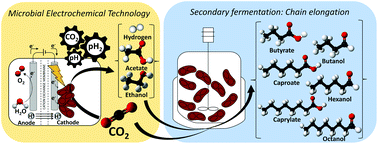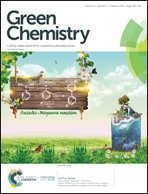Unravelling the factors that influence the bio-electrorecycling of carbon dioxide towards biofuels†
Abstract
Reliable operational procedures for the control of Microbial Electrochemical Technologies (METs) to produce suitable substrates for economically viable downstream applications were investigated. We aimed at levelling key operational conditions in a model electrosynthetic reactor in order to obtain biofuels from carbon dioxide (CO2). The cathodes of two tubular bioelectrochemical systems (BESs) were inoculated with an enriched culture of a carboxydotrophic strain and were operated until stable conversion of CO2 into acetate and ethanol. Both reactors averaged a production of 76 ± 9 mgethanol m−2 d−1 and 120 ± 29 mgacetate m−2 d−1, which were considered crucial for triggering the production of longer carbon chain carboxylates and alcohols in a chain elongation bioreactor. Changes in the current signal and pH were correlated with CO2 depletion and the transition from acetogenesis to solventogenesis in the enriched culture. We show that in-line monitoring of pH and electron consumption are meaningful operational variables to differentiate between the two biological processes, and open the door to develop new approaches to control the bioelectro-recycling of CO2 into biofuels by METs.



 Please wait while we load your content...
Please wait while we load your content...